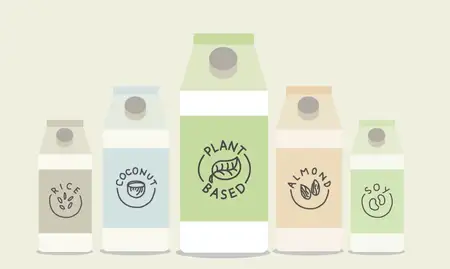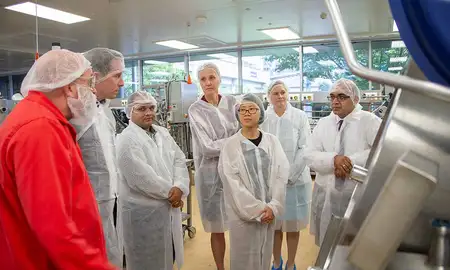
A new study has shown cherries have an impressive antioxidant and vitamin profile.
Cherries can join the ranks of blueberries and other colourful fruits grown in New Zealand with their impressive antioxidant and vitamin profile, according to research done at the Riddet Institute on Massey's Manawatū campus.
The research into New Zealand cherries was jointly funded by a grant from the High-Value Nutrition National Science Challenge to Cherri Health and Manufacturing (CH&M) and the Bioresource Processing Alliance with Cherri Global.
The work was carried out by scientists at the Riddet Institute and Plant and Food Research over the course of several months in late 2022.
Riddet Institute Lead Scientist Dr Ali Rashidinejad says the study is the first of its kind to systematically analyse the nutritional and bioactive (phytochemical) compositions of the main cherry varieties grown in New Zealand. Earlier research has focused on cherries grown overseas.

Dr Ali Rashidinejad.
Dr Rashidinejad says cherries contain numerous nutrients such as vitamins A, E, K, C and B, carotenoids, lutein and zeaxanthin. Cherries have been recognised for providing significant health benefits such as decreasing markers for oxidative stress, inflammation, exercise-induced muscle soreness and loss of strength. They are also thought to improve blood pressure, arthritis and sleep.
Dr Rashidinejad says there are 17 main varieties grown in New Zealand. This study focused on six top-selling varieties grown in Cherri Global orchards in Otago: Bing, Rainier, Kordia, Lapins, Sweetheart and Staccato.
The study also compared fresh and packaged cherries to learn if nutrients were lost during processing.
Researchers looked at proteins, carbohydrates, sugars, fats, fibre, fat-soluble vitamins and water-soluble vitamins.
“Basically, in terms of nutrient profiles, we have explored everything we could. And the same with the bioactive compounds,” Dr Rashidinejad says.
“We concluded that all six varieties were rich sources of different nutrients: minerals, vitamins, amino acids and phenolic compounds – the antioxidants. These latter compounds, the phenolic compounds, were what most interested us because they are potent antioxidants with numerous scientifically proven health-promoting properties.”
Dr Rashidinejad says almost 30 phenolic compounds were studied, in collaboration with Plant and Food Research, using high pressure liquid chromatography techniques.
Most of these compounds were present in differing amounts, with vitamins A, C, E, B1, B2, B3, B6, B9 (folate) and K also detected and quantified in the fresh, packaged and frozen cherry samples. High concentrations of vitamin C were confirmed.
Dr Rashidinejad says the cherry season is quite short, with early varieties ripening in late December and all finished by early February.
The delicate stone fruit are not easy to grow, requiring extensive bird protection. They are also labour intensive to pick and process.
After picking, cherries are washed at packhouses and exported or distributed around the country, either fresh or frozen. The comparison between fresh and packaged fruit found processing had varying effects on the nutrients and bioactive compounds of the fruit.
“We found only some minor differences and little effect from the time and the process of washing, drying and packing. It’s good news that the transport and packing does not have a major effect on the health-promoting compounds," Dr Rashidinejad says.
He adds that the findings were exciting for the future opportunities that could be explored.
“This has been a comprehensive study. The hypotheses have been confirmed that New Zealand cherries are a great source of antioxidants and nutrients and that the processing has a little or no impact on their nutritional properties.”
Dr Rashidinejad says future steps would be finding ways to use the waste products produced during cherry processing. It has been estimated that 8000 tonnes of cherry waste are produced in New Zealand every year.
Because washing and packaging does not significantly reduce the nutrient profile of the fruit, this could lead to new uses for the waste or the seconds that don’t get to shop shelves.
He says such waste from cherries could be converted into a high-value ingredient for the food industry in the future. This could be in powdered or frozen form, or as a component in another food product.
The Riddet Institute is a Centre of Research Excellence hosted by Massey University, which focuses on fundamental and advanced food research. Cherri Global, based in Hawke’s Bay, has a business division focused on developing a range of Cherry products focused on health and eliminating waste.
Related news
Study finds milk substitutes have high cost and low nutritional benefits
Plant-based beverages are expensive and provide only a small fraction of the nutritional goodness of cow’s milk, according to a new study.

Nestlé acquires New Zealand technology to help fight iron deficiency
Global food company Nestlé has acquired a novel technology developed by New Zealand scientists that will enable it to address iron deficiency.

Can kiwifruit reduce exercise-induced stress in active women?
While exercise as part of a healthy lifestyle can prevent communicable diseases, it can also cause a stress response.
